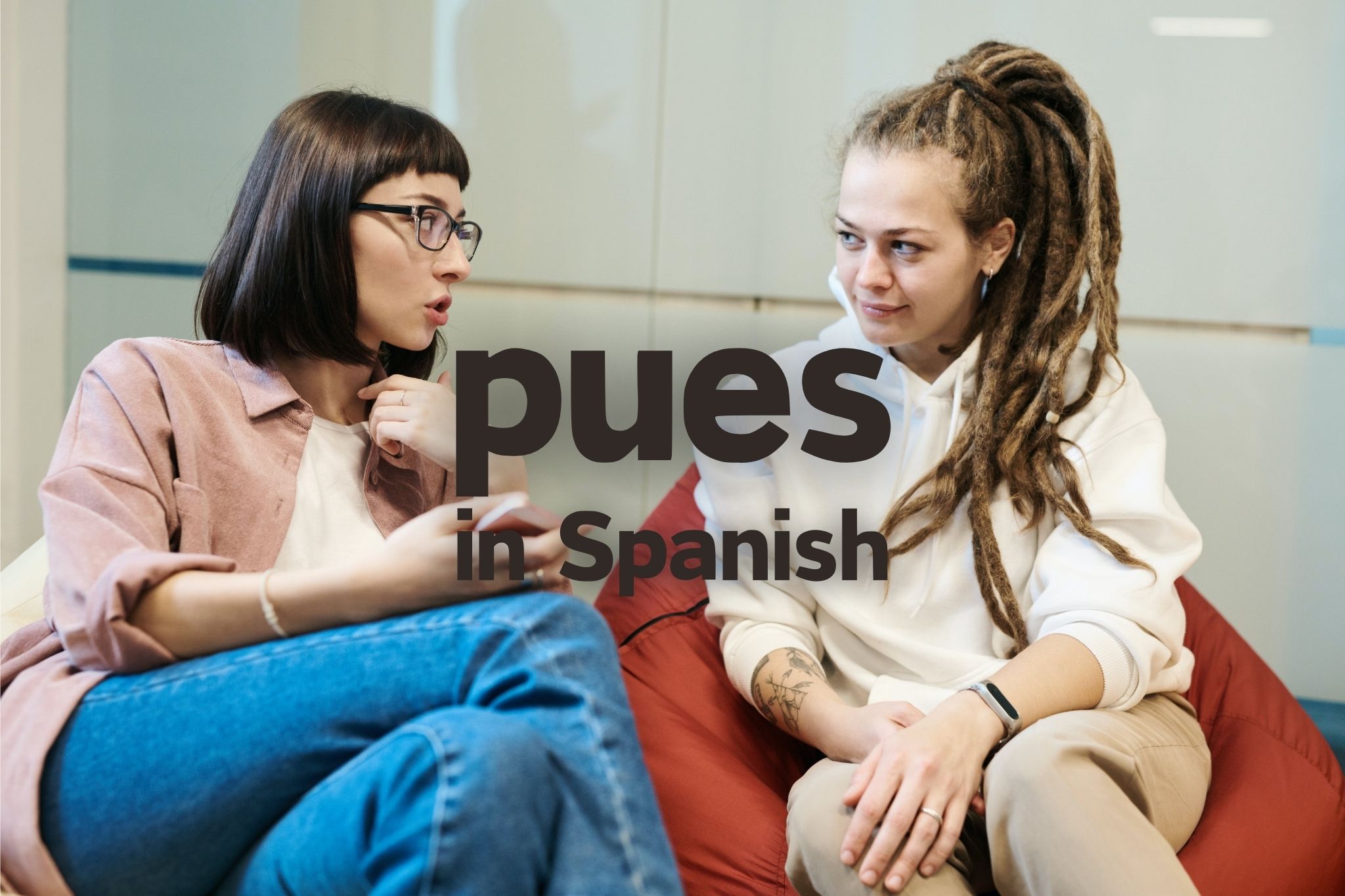How to use Pues in Spanish: A complete guide

Get our free email course, Shortcut to Conversational.
Have conversations faster, understand people when they speak fast, and other tested tips to learn faster.
More infoPues is one of those Spanish words that you’ll see everywhere and really need to know if you want to sound like a native Speaker. Depending on the context, it can be used as a conjunction, a filler word or an emphasizing tool.
Don’t worry, we’ll provide you with plenty of examples so you know exactly what we’re talking about, and get a clear view of how to use it.
Let’s get started!
Pues in Spanish: Meaning
So, what does pues mean in Spanish exactly? Well, it actually depends on the role it plays in the sentence. If it’s working as a conjunction its most common translations for this word are since, then or so. As an adverb, it’s translated as yes, or of course, while as a filler word, it’s usually translated as well. Now, let’s move on to the uses of pues in Spanish.
Pues as a conjunction
As a conjunction, pues is used to connect sentences or clauses. There are four main ideas that pues expresses as a conjunction:sequence or consequence, reason or cause, emphasis, and question.
Sequence or consequence
When used to denote continuity, pues indicates a logical progression from one statement to another. This is usually translated as then or thus.
- Una vez que sacamos el pan del horno, pues debemos dejarlo enfriar. – Once we take the bread out of the oven, then we must let it cool.
- ¿No tienes ganas de salir? Pues quédate en casa. – Don’t feel like going out? Then stay at home.
- Repito, pues, lo que ya te había dicho. – I repeat, then, what I have already told you.
Reason or cause
In this context, pues expresses the reason or cause behind a certain action or situation. It can be interpreted as since, for or because, depending on the sentence.
- Estoy lleno todavía, pues comí mucho al desayuno. – I am still full because I ate a lot at breakfast.
- No pude ver el juego, pues llegué tarde del trabajo. – I couldn’t watch the game, as I got home late from work.
- Voy a dormir temprano, pues estoy cansado. – I’m going to bed early, because I’m tired.
Question
When used alone in a question, pues takes the sense of “how?” or “why?”
- Terminé con Paola. / ¿Pues? / Ya no se sentía agusto con la relación. – I broke up with Paola. / Why? / She was no longer comfortable with the relationship.
- Creo que me equivoqué al anotar el número del profesor. / ¿Pues? / Me dice “número inválido” – I think I made a mistake when I wrote down the teacher’s number. / Well? / It says “invalid number”.
- Se me rompió el reloj que me dio mi papá. / ¿Pues? / Lo dejé caer por accidente. – The watch my dad gave me broke. / Well? / I dropped it by accident.
- Mejor quedémonos en casa esta noche. / ¿Pues? / Parece que va a haber tormenta. – We’d better stay home tonight. / Well? / Looks like it’s going to storm.
Emphasize opinions
Pues can be employed to emphasize statements, opinions or explanations, adding weight or significance to it.
- ¿Me ayudas con esto? / ¡Pues claro! ¿Qué necesitas? – Can you help me with this? / Of course! What do you need?
- ¿Y cuál es el problema, pues? / ¡Que no tuve tiempo para estudiar, pues! – So, what’s the problem? / So I didn’t have time to study!
- ¿Tienes ganas de comer algo? / Pues sí. Vamos a por unas hamburguesas. – Do you feel like eating something? / Well, yes. Let’s go get some hamburgers.
- No puedo creer que no quieras acompañarme. / ¡Pues no quiero! ¡Y ya no me insistas! – I can’t believe you don’t want to join me. / Well, I don’t! And don’t push me anymore!
- ¿De verdad te enojaste por eso? / ¡Pues sí! – Are you really mad about that? / Yes, I am!
Pues as an adverb
As and adverb, pues is equivalent to the affirmative Spanish adverb sí used as an answer. However, this use is not that common in everyday conversations.
- ¿Te dijo algo malo de mí? / Pues. – Did he tell you something bad about me? / Yes.
- ¿Estás segura de lo que estás diciendo? / Pues. – Are you sure about what you’re saying? / Yes.
Pues as a filler word
Pues is also commonly used as a filler word in Spanish. As a filler, its usage varies depending on the context and speaker’s intention. As a filler word, pues is most commonly interpreted as well, so, then and even ummm. It’s used to convey doubt or hesitation, disappointment, or just to fill the space in a sentence.
- Oye, ¿quieres ir al cine? / Pues… no sé. Hoy estoy un poco ocupado. – Hey, do you want to go to the movies? / Well… I don’t know. I’m a little busy today.
- ¿Por qué la cara triste? / Pues nos perdimos el evento. No sé cuándo tendremos otra oportunidad así. – Why the sad face? / Well, we missed the event. I don’t know when we’ll have another chance like this.
- Estaba hablando y pues, no recuerdo qué le dije, pero, pues, se enojó mucho. – I was talking and, well, I don’t remember what I said, but, well, he got very angry.
Conclusion
Congratulations! You’ve made it through our comprehensive guide on how to use pues in Spanish. Now, let’s recap what we’ve learned.
Pues is a versatile word that can function as a conjunction, adverb, or filler word, depending on its role in the sentence. As a conjunction, pues is used to connect sentences or clauses, expressing continuity, reason, consequence, emphasis, or in questions. When used as an adverb, it has an affirmative function, similar to sí in Spanish. Additionally, pues can also serve as a filler word, conveying things like doubt, hesitation, or disappointment, or just to fill space in a sentence.
As you can see, pues in Spanish is everywhere, so mastering it will enhance your language skills and help you communicate more effectively. So, keep practicing and incorporating “pues” into your conversations to sound more like a native speaker!



